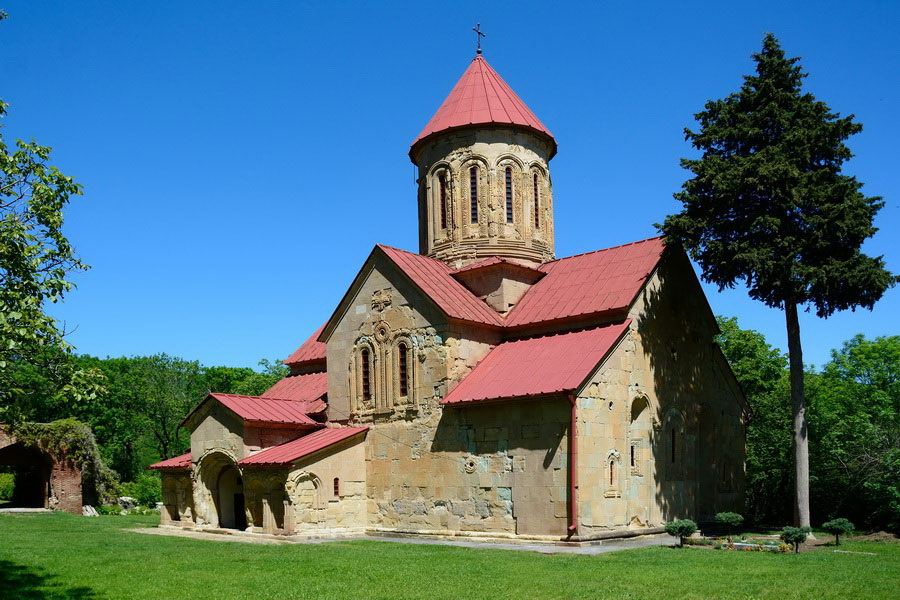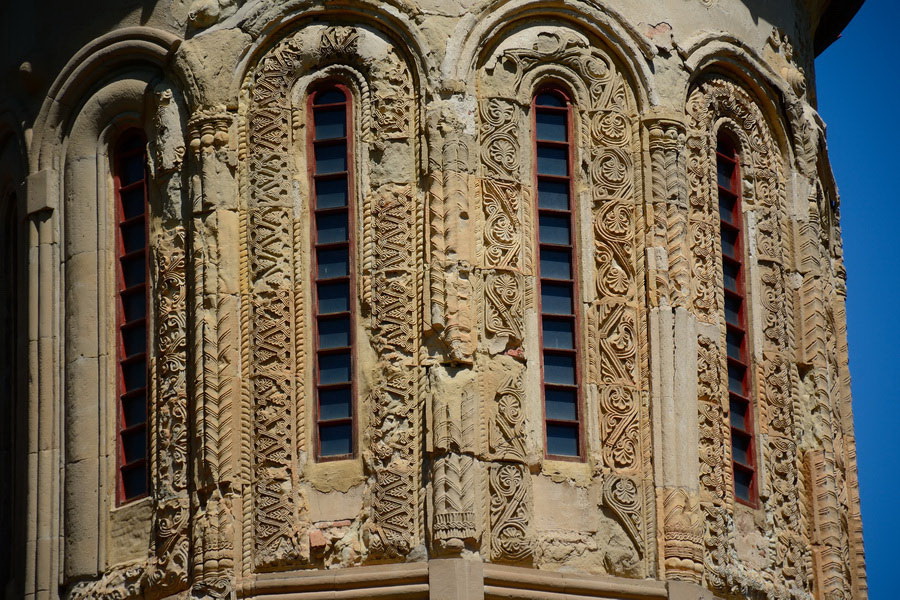
There is a remarkable monument of the Christian culture in the surroundings of Tbilisi (20km away) – Betania monastery built in 12-13th centuries. Visiting it today means exploring a site already listed in the top things to do in Tbilisi, where history and spirituality merge in a unique way. Betania (Bethania) is an acting sanctuary erected in the honor of the Nativity of the Mother of God. The place is located in the woody gorge of the Vere (Vera) river, with two churches on its territory. The main big temple reminds a pearl with its pinkish tint. Inside you will find preserved murals of the year 1207 that depict the King George III and his daughter – Queen Tamar.
History of the monastery
It is little know about the history of this unique construction. There is no information about the exact dates of its erection. The main church of the Nativity of the Mother of God was built approximately in the 12th century; the St. George Church, another one less in size, was built earlier – in 1196/07. Scientists date the murals in the Nativity church to 1207. However, there is an assumtion, that buildings appeared there one century earlier, and in the 1200’s there was a reconstruction of the church, and the interior was completed with murals.
The name of the monastery is derived from the Palestinian settlement. There is nothing known about the foundation of the construction, but it is suggested that it could be the Orbeli brothers (princes/dukes) whose familial lands were nearby.
Services had been held for many years in the abbey, and monks had lived on its territory. Later Betania had served as a family vault for the Baratashvili clan for some time. However, the monastery was left neglected, abandoned and forgotten by people. Dilapidated church was accidentally discovered by an architect and artist Gagarin, approximately in 1850. Gagarin studied the interior of the half-destroyed old building, and found the mural with the image of the Queen Tamar; later reported to the public. There was so much excitement around the monastery as it was already few centuries old. The temple was restored, and received back its historical significance.
Since then, the monastery was operating, and in 1936, a mill had been attached to it. During the period of the Soviet rule, the government ordered to stop the activity of the church and change its status to the historical monument, though residing monks were given permission to stay in the monastery to serve as guardians of the valuable object.
The entire initial décor and façade of the buildings were practically destroyed during the last years and were subject to restorations several times. There are only few little elements left from the original.
Architecture and the painting of the Nativity Church

Chronicles do not tell us when and who built the monastery. It was only possible to track the history of the holy place according to the preserved murals that are dominant in its interior. Scientists had to compose the image of the past from the excerpts of writings on the walls of the church and conservative forms of architecture.
Today, if you take the way to the Betania monastery through the gorge of the River Vera, you will see brick gates. To left of them, there are still remains of once existed walls and the spring. The Nativity Church of the Mother of God is located right behind the gates, and to the right of them, there are utility rooms.
The Nativity Church is a classic cross-domed structure with a conical dome on a cylindrical drum with 12 windows (symbolizes the number of apostles). A dilapidated construction is adjoining the western part. Scientists suggest that there was once a tower. The southern side has a portal with arches. The sandstone used for the construction of the church had weathered during those 800 years. The entire facing was done anew. Recently the roof has been replaced as well – now it is made of metal tile and tin.
The monastery is famous with its murals; they particularly are of great value for historians. The most significant fragment is the portrait image of the Queen Tamar placed on the northern wall. Below, on the same wall, there is a mural with the image of the King George III surrounded with his daughter and a son, guarded by two saint warriors. This fresco was re-done several times, but the contemporary restorers managed to reproduce its initial look with the help of high technology equipment. The windows of the northern walls are adorned with rare iconographic frescoes: “Judas and 30 pieces of silver”, “Judas Iscariot”, “Agony in the Garden”, Saint Peter”, Pontius Pilate”. Together all these elements demonstrate the entire cycle of the Crucifixion of Jesus Christ the Savior.
The western wall is adorned with a series of murals depicting the wonders of the Christ after his Resurrection. The southern wall has preserved a cycle of famous murals of a much earlier period. It consists of 9 images of prophets with the foreseen prototypes symbolizing the Mother of God. Scientists believe that it is not only the oldest, but also the most extended and detailed cycle. The image of David dancing at the Ark of the Covenant with manna from heaven in his hands has been preserved best of all.
It is possible to read high skillfulness and deep spirituality of artists in each fresco. Even centuries later, these images emanate some kind of awe to the Kingdom of Heaven. Today this monastery is considered the brightest sample of the Georgian temple architecture.

